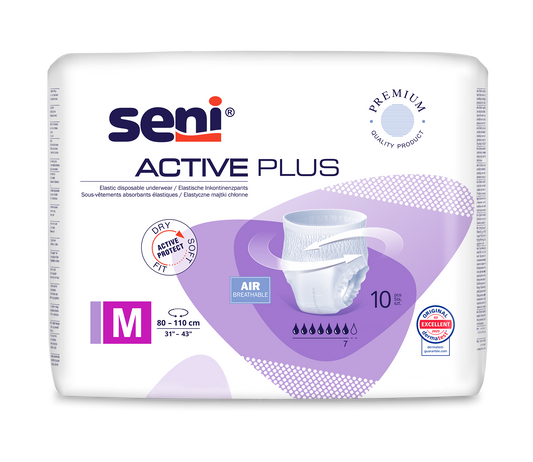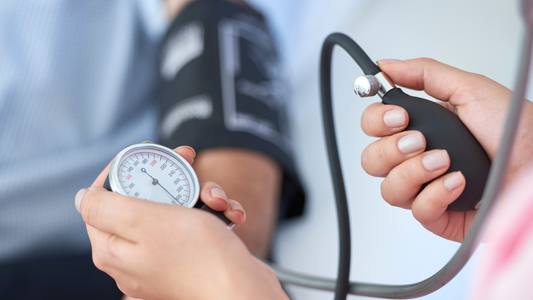
Strong women, weak heart? The inexhausted truth about women and heart attacks
Imagine you live your life, juggling between job, family, friends and all the expectations that are placed on you. They work - always, every day. But suddenly, without warning, they feel a pressure that spreads, perhaps only a slight pull, a feeling of weakness that they cannot classify. "It's just stress," they think. But what if it is more? What if it is your heart that would like to tell you in his silence that you need help?
Heart attacks are often considered "male disease", but the truth is that they meet women as often - often with more fatal consequences. The symptoms in women are often non -specific and are therefore easily overlooked. In this article we want to look closely: Why do so many women die from a heart attack? What do the symptoms look like and what makes them so dangerous? And above all: How can we make sure that women no longer die "quietly" from a heart attack?
What do the current numbers say?

In Germany, between 60,000-90,000 women suffer a heart attack every year. These are not just numbers, these are mothers, daughters, sisters. Women are on average younger affected than previously assumed, often between the 60th and 70th year of life.
If we compare these numbers with the men, the differences are not huge, but significant: 62,000 men a heart attack in Germany. However, men are affected a little younger on average, usually between the ages 50 and 60 years.
Mortality rate: an alarming knowledge
While men suffer a heart attack more often, it is Mortality rate higher in women. Current statistics show that about 54% of the people who die from a heart attack, women are. This is mainly due to the fact that the symptoms in women are often more subtle and heart attacks are therefore recognized and treated later.
The underestimated symptoms - this is how a heart attack in women expresses itself
The classic symptoms in men
- Strong, oppressive chest painthat often radiate in the left arm, jaw or back
- Sweating
- Shortness of breath
- Nausea and vomiting
The typical symptoms in women - the quiet warning signs
Women often experience other, more subtle symptoms that are not immediately associated with a heart attack:
- Shortness of breath: Women often feel a sudden, inexplicable shortness of breath, even with low physical exertion or in peace.
- Discomfort or feeling of pressure in the upper abdominal area: It feels like strong heartburn, stomach upset or nausea.
- Back pain: Especially pain in the upper back or between the shoulder blades are a common sign of women.
- Dizziness and strong fatigue: Many women suddenly feel extremely exhausted or weak, often accompanied by dizziness.
- Jaw and neck pain: This rather atypical pain does not let many women think of a heart attack.
- Calatitude and a general feeling of "discomfort".

Why these differences?
The reason why women show different symptoms lies in the fact that women tend to Smaller coronary arteries have as men. As a result, the narrowing of the vessels in women is different, and diffuse symptoms can occur.
Silent heart attacks as an unnoticed danger
A "stummer" or "silent" heart attack is a heart attack that runs without the typical, strong warning signals that are usually connected to a heart attack. This means that those affected often feel no or very low pain sensations and the symptoms are so inconspicuous that they either ignore them or confuse them with other more harmless symptoms. Often, a blank heart attack is only discovered later by chance, for example during a routine examination or on an electrocardiogram (EKG).
Why is it called "silent"?
The term "silent" refers to the fact that the usual, striking symptoms of a heart attack, such as strong chest pain, sweating or shortness of breath, are missing or are so mild that they are easily overlooked. Since the signs do not clearly indicate a heart attack, they often remain unnoticed.
How often are silent heart attacks?
Silent heart attacks are relatively common and make an estimated 20-25% of all heart attacks out of. In women, the elderly and diabetics, silent heart attacks occur more often.
How is a blank heart attack diagnosed?
Since the symptoms are not obvious, a blank heart attack is often discovered by chance. Possible diagnostic procedures are:
- Electrocardiogram (EKG): An EKG can show changes in cardiac activity that indicate an earlier heart attack.
- Echocardiography (heart ultrasound): This means that areas of the heart muscle can be identified, which may be damaged by a heart attack.
- Blood tests: Troponin is a heart muscle protein that is released in a heart attack. In the case of silent heart attacks, the troponine level may be increased, but often not as clear as with typical infarctions. This serves this CLEARTEST® Troponin I thoroughbred infarct test. This is a faster and reliable test for determining Troponin I, a protein that is released into the bloodstream when the heart attack is released. The test enables a quick diagnosis of heart attacks directly on site
Long -term consequences of a silent heart attack
A blank heart attack can be as harmful to the heart as a "normal" heart attack. Long -term consequences include:

Why is recognition so important?
A blank heart attack is just as dangerous as a "loud" heart attack, since it remains unnoticed and no timely treatment takes place. Heart damage can thus progress and there is an increased risk of future heart problems.
Causes of a heart attack - why women are particularly at risk
The causes of a heart attack are similar in women and men, but some risk factors have a stronger effect on women:
Common risk factors
- Hypertension: Increases the risk of both sexes, but especially after menopause.
- High cholesterol level: Leads to deposits in the arteries that endanger the heart.
- diabetes: Women with diabetes have one triple risk for a heart attack compared to men.
- Smoke: Increases the risk of heart attacks in women even more than in men.
- Obesity and lack of exercise: These factors also increase the risk of both sexes.
Specific risk factors for women
- Hormonal changes: After the menopause, the estrogen level, which has protected the cardiovascular system until then, drops. The risk of a heart attack increases significantly.
- Autoimmune diseases: Women are more often affected by autoimmune diseases such as lupus or rheumatoid arthritis that increase the risk of heart attacks.
- Psychosocial factors: Stress, depression and anxiety disorders affect the heart in women and increase the risk of heart diseases.
Diagnostic procedures - this is how a heart attack is recognized
The challenges in women
Heart attacks in women are often more difficult to diagnose because the symptoms are more unspecific. Many women only come to the emergency room when it is almost too late.
The most important diagnostic methods
- Electrocardiogram (EKG): Displays the electrical activity of the heart and can provide information on a heart attack.
- Blut tests: Troponin is a protein that is released in the event of a heart attack and can be detected in the blood.
- Echocardiography: Ultrasound examination of the heart to assess the heart function.
- Coronary angiography (cardiac catheter): A catheter is inserted into a blood vessel to make blockages visible in the coronary arteries.
Treatment of a heart attack in women
Acute treatment
- Medicine therapy: blood thinners (e.g. heparin), pain relievers, blood pressure lowerer and nitroglycerin to expand the blood vessels.
- Reopening of the closed vessel: percutaneous coronary intervention (PCI), in which a stent is used, or thrombolysis (dissolution of the blood clot by medication).
- Bypass surgery: In severe cases in which several vessels are affected, a bypass operation is carried out.
Long -term treatment
- Blood pressure control, reduction in cholesterol and diabetes management
- Lifestyle changes, including change of diet and regular movement
Gender differences in medicine - why do women's hearts beat differently
Women are often underrepresented in medical research and diagnostics. Most studies have been carried out on men, which often overlooked typical female symptoms and reaction patterns. The "male" symptoms have long been defined as a standard, which is why women often get the right diagnosis later or not at all.

Prevention and health care - this is how you protect your heart
Prevention and health care are essential to keep the heart healthy and prevent cardiovascular diseases. Here are some important strategies to protect your heart:
Healthy eating
- Lots of fruit and vegetables: they contain vitamins, minerals and antioxidants that protect the heart.
- Whole grain products: whole grain bread, oatmeal and rice rice deliver fiber that lower the cholesterol level.
- Healthy fats: prefer unsaturated fats from nuts, avocados, olive oil and fish. Reduce saturated fats from meat and dairy products.
- Less salt: High salt consumption increases blood pressure, so it is important to limit salt intake.
Regular movement
- Aerobes training: activities such as jogging, cycling or swimming strengthen your heart.
- Building muscle: strength training supports heart health by improving metabolism.
- 30 minutes a day: Attempts to do 30 minutes of moderate sport on at least five days a week.
Reduce risk factors
- Not smoking: Smoking damages the blood vessels and increases the risk of heart attacks.
- Restrict alcohol consumption: excessive alcohol consumption can increase blood pressure and weaken the heart.
- Stress management: Chronic stress puts a strain on the heart. Relaxation techniques such as yoga, meditation or breathing exercises can help.
Weight control
- A healthy body weight reduces the risk of high blood pressure, diabetes and other cardiovascular diseases.
- A body mass index (BMI) between 18.5 and 24.9 is considered optimal.
Regular health checks
- Blood pressure control: normal blood pressure is around 120/80 mmHg. Create your own at home Blood pressure monitor to. In addition, a blood pressure diary is recommended. Present this to your supervising family doctor or cardiologist if necessary.
- Monitor cholesterol values: High LDL cholesterol levels (bad cholesterol) increase the risk of heart problems.
- Test blood sugar levels: particularly important for people with diabetes risk.
Enough sleep
- 7-9 hours of sleep a night support heart health and help to avoid high blood pressure and inflammation.
Beware of previous illnesses
- Diabetes: Good blood sugar control is crucial.
- Hypertension: regular use of medication and lifestyle changes are important.
- High cholesterol values: A change in diet and movement can help reduce the values.
Through these measures you can actively help keep your heart healthy and reduce the risk of cardiovascular diseases.

































